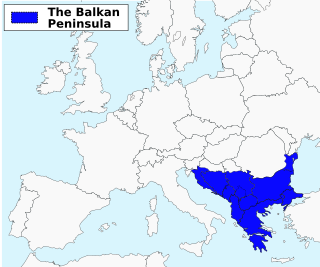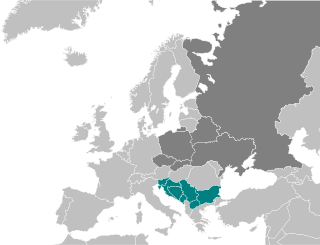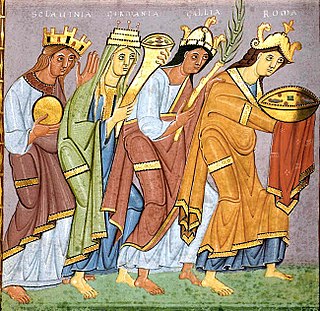
The Treaty of Belgrade, also known as the Belgrade Peace, was the peace treaty signed on September 18, 1739 in Belgrade, Habsburg Kingdom of Serbia, by the Ottoman Empire on one side and the Habsburg monarchy on the other, that ended the Austro–Turkish War (1737–39). It also recognized Circassia, particularly its eastern half Kabardia, as an independent nation for the first time by the European countries.

Bulgarians are a nation and South Slavic ethnic group native to Bulgaria and its neighbouring region, who share a common Bulgarian ancestry, culture, history and language. They form the majority of the population in Bulgaria, while in North Macedonia, Ukraine, Moldova, Serbia, Romania, Hungary, Albania, Turkey and Greece they exist as historical communities.

The Balkans and parts of this area may also be placed in Southeastern, Southern, Eastern Europe and Central Europe. The distinct identity and fragmentation of the Balkans owes much to its common and often turbulent history regarding centuries of Ottoman conquest and to its very mountainous geography.

The Archbishopric of Ohrid, also known as the Bulgarian Archbishopric of Ohrid, originally called Archbishopric of Justiniana Prima and all Bulgaria, was an autocephalous Eastern Orthodox Church established following the Byzantine conquest of Bulgaria in 1018 by lowering the rank of the autocephalous Bulgarian Patriarchate due to its subjugation to the Byzantines. In 1767, the Archbishopric's autocephaly was abolished, and the Archbishopric was placed under the tutelage of the Patriarchate of Constantinople.
The Kruševo Manifesto is a presumable manifesto published by the Revolutionary Committee of Kruševo Republic during the 1903 Ilinden-Preobrazhenie Uprising. It was calling upon the Muslim population to join forces with the republican government in the struggle against tyranny and to attain democratic form of statehood. It urged that the uprising was against the Sultanate, and was not religiously or ethnically based. More, this manifesto is cited by modern Macedonian historiography as historical example of the use of a separate Macedonian language during the uprising. However there is no original preserved and its historical authenticity is disputed. Macedonian historiography refers to a text that was compiled about twenty years after the events. It was published in 1923 by Nikola Kirov in Sofia in his native dialect, as part from a play. In fact at the turn of the 20th century there were only a few researchers who claimed that a separate Macedonian language existed. Though, Macedonian historians object to Kirov's classification of then Krusevo's Slavic population as Bulgarian.

Kuber was a Bulgar leader who, according to the Miracles of Saint Demetrius, liberated a mixed Bulgar and Byzantine Christian population in the 670s, whose ancestors had been transferred from the Eastern Roman Empire to the Syrmia region in Pannonia by the Avars 60 years earlier. According to a scholarly theory, he was a son of Kubrat, brother of Khan Asparukh and member of the Dulo clan.

South Slavs are Slavic people who speak South Slavic languages and inhabit a contiguous region of Southeast Europe comprising the eastern Alps and the Balkan Peninsula. Geographically separated from the West Slavs and East Slavs by Austria, Hungary, Romania, and the Black Sea, the South Slavs today include Bosniaks, Bulgarians, Croats, Macedonians, Montenegrins, Serbs and Slovenes.

The Sclaveni or Sklabenoi were early Slavic tribes that raided, invaded and settled in the Balkans in the Early Middle Ages and eventually became one of the progenitors of modern South Slavs. They were mentioned by early Byzantine chroniclers as barbarians having appeared at the Byzantine borders along with the Antes, another Slavic group. The Sclaveni were differentiated from the Antes and Wends ; however, they were described as kin. Eventually, most South Slavic tribes accepted Byzantine or Frankish suzerainty, and came under their cultural influences and Chalcedonian Christianity. The term was widely used as a general catch-all term until the emergence of separate tribal names by the 10th century.

The Seven Slavic tribes, or the Seven clans were a union of Slavic tribes in the Danubian Plain, that was established around the middle of the 7th century and took part in the formation of the First Bulgarian Empire together with the Bulgars in 680−681.

The Battle of Ongal took place in the summer of 680 in the Ongal area, an unspecified location in and around the Danube delta near the Peuce Island, present-day Tulcea County, Romania. It was fought between the Bulgars, who had recently invaded the Balkans, and the Byzantine Empire, which ultimately lost the battle. The battle was crucial for the creation of the First Bulgarian Empire.
The term Maleševo-Pirin or Maleshevo-Pirin or Pirin-Maleshevo dialect is used in South Slavic linguistics to refer to a group of related varieties that are spoken on both sides of the border of Bulgaria and the Republic of North Macedonia. Some linguists treat them as dialects of the Bulgarian language, while Victor Friedman views them as part of Macedonian. According to some authors, they are linguistically transitional between the two national languages, Bulgarian and Macedonian and form part of the larger dialect continuum between them. The dialect group is named after the mountain ranges of Pirin in Bulgaria and Maleševo in Macedonia. When referring specifically to the dialects on the Bulgarian side, the term Petrich-Blagoevgrad dialect, after the two major towns in the area, is also used.

Much of the territory of the modern state of Serbia was part of the Roman Empire and later the Eastern Roman Empire. In particular, the region of Central Serbia was under Roman rule for about 800 years, starting from the 1st century BC, interrupted by the arrival of the Slavs into the Balkans during the 6th century, but continued after fall of the First Bulgarian Empire in the early 11th century and permanently ended with the rise of the Second Bulgarian Empire in the late 12th century. The territories were administratively divided into the provinces of Moesia, Pannonia and Dardania. Moesia Superior roughly corresponds to modern Serbia proper; Pannonia Inferior included the eastern part of Serbia proper; Dardania included the western part of Serbia proper. After its reconquest from the Bulgarians by Emperor Basil II in 1018, it was reorganized into the Theme of Bulgaria.

The Kingdom of Serbia, or the Serbian Kingdom, was a medieval Serbian state that existed from 1217 to 1346 and was ruled by the Nemanjić dynasty. The Grand Principality of Serbia was elevated with the regal coronation of Stefan Nemanjić as king, after the reunification of Serbian lands. In 1219, Serbian Orthodox Church was reorganized as an autocephalous archbishopric, headed by Saint Sava. The kingdom was proclaimed an empire in 1346, but kingship was not abolished as an institution, since the title of a king was used as an official designation for a co-ruler of the emperor.

The resolution of the Comintern of January 11, 1934, was an official political document, in which for the first time, an authoritative international organization has recognized the existence of a separate Macedonian nation and Macedonian language.

The royal Tetraevangelia of Ivan Alexander is an illuminated manuscript Gospel Book in middle Bulgarian, prepared and illustrated in 1355–1356 for Tsar Ivan Alexander of the Second Bulgarian Empire. The manuscript is regarded as one of the most important manuscripts of medieval Bulgarian culture. The manuscript, now in the British Library, contains the text of the Four Gospels illustrated with 366 miniatures and consists of 286 parchment folios, 33 by 24.3 cm in size.
Balik was a noble of the Second Bulgarian Empire who increased the autonomy of his province and became despot of the Principality of Karvuna. An account cited that he finally broke away from the empire in the 1340s and, as a result, the dioceses in his region, which was later named Dobrudja, were subsumed under the jurisdiction of the Patriarchate of Constantinople. This came after Tsar Ivan Alexander divided Bulgaria into three territories that were held by his sons.

The Bulgarian Turks in Turkey represent a community of Bulgarian Turks who immigrated over the years from Bulgaria to Turkey. They are notable in Turkey for being descendants of Balkan Turks who had to escape persecution. and moreover, part of them continue to be dual citizens of Bulgaria and Turkey, which makes them a natural bridge between both countries.
The Eastern South Slavic dialects form the eastern subgroup of the South Slavic languages. They are spoken mostly in Bulgaria and North Macedonia, and adjacent areas in the neighbouring countries. They form the so-called Balkan Slavic linguistic area, which encompasses the southeastern part of the dialect continuum of South Slavic.
James Franklin Clarke, Jr. was an American historian who dedicated his life to the study of the history of the activities of American Protestants and their missionaries on the Balkans, and especially contributed to the spreading of Protestantism in Bulgaria. He founded the Academic Studies on Bulgarian history in the United States.
Several scholars of nationalism support the existence of nationalism in the Middle Ages. This school of thought differs from modernism, the predominant school of thought on nationalism, which suggests that nationalism developed largely after the late 18th century and the French Revolution. Theories on the existence of nationalism in the Middle Ages may belong to the general paradigms of ethnosymbolism and primordialism (perennialism).













